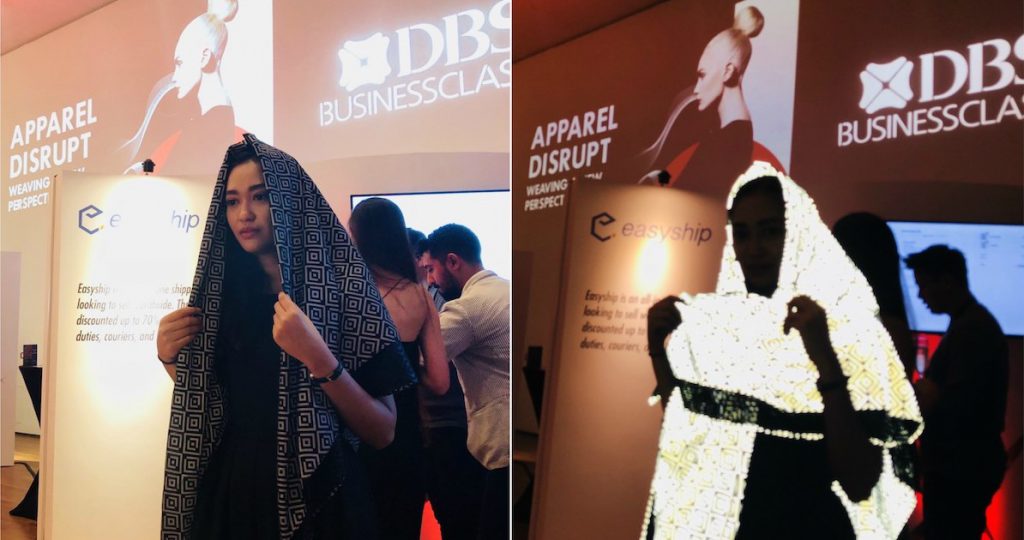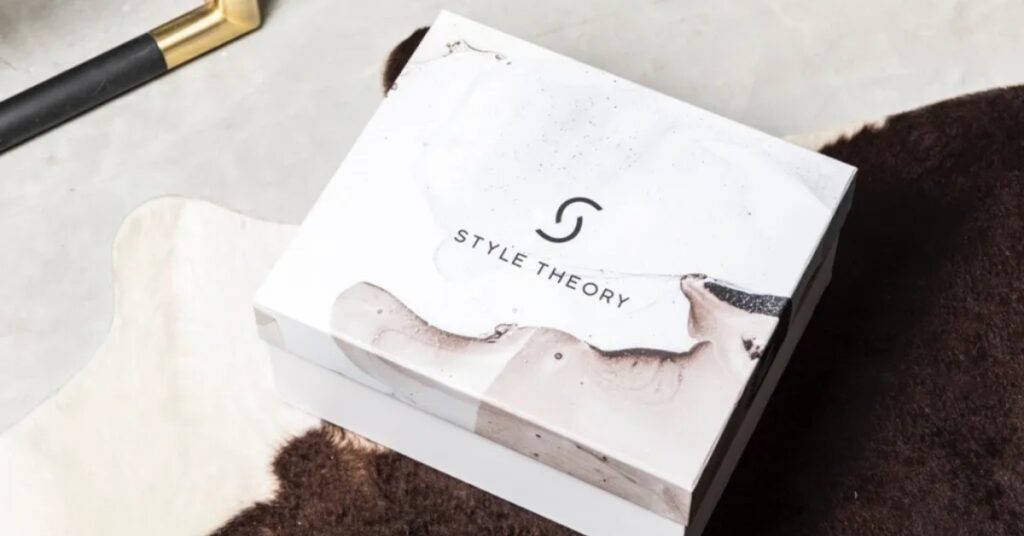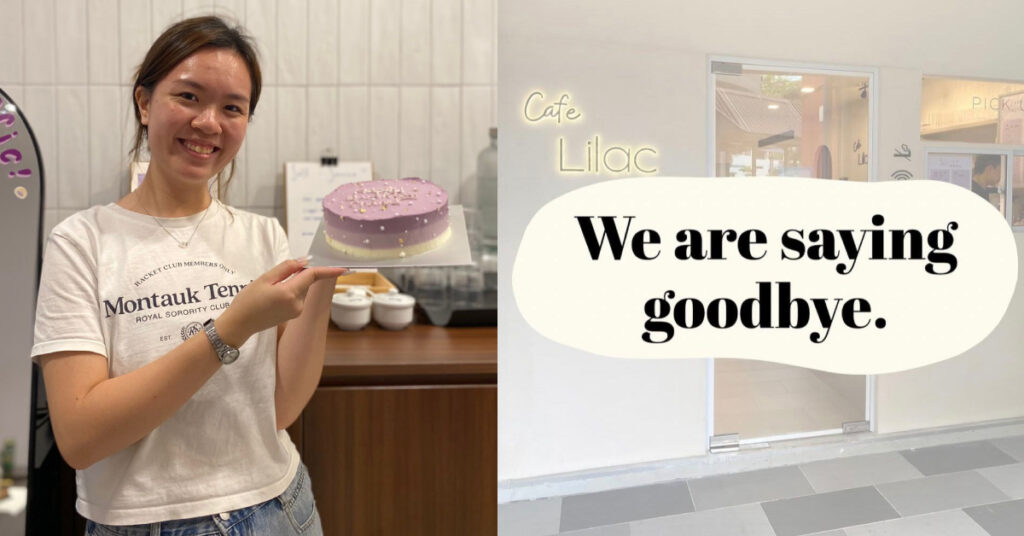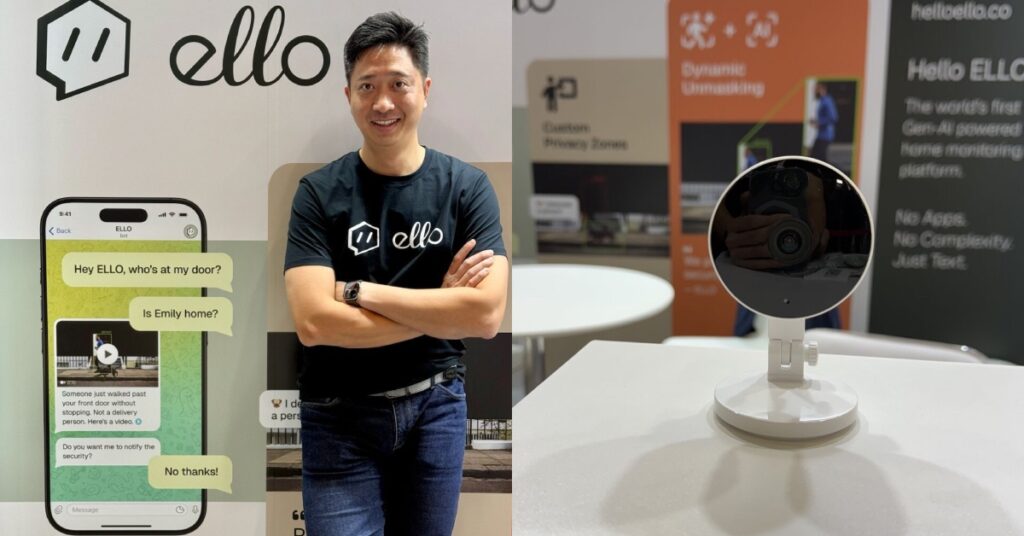Technology has pretty much become an essential that we cannot live without – and it’s becoming so pervasive that it’s even breaking into the fashion industry.
In fact, tech giants like Amazon, Apple and Google are all trying to carve their own path into the fashion space.
Apple’s doing so with its Apple Watch Hermès smartwatches, Amazon with its voice-controlled cameras that provide fashion advices, and Google with conductive fabrics embedded in a Levi’s smart jacket.
As the lines are blurred between these two industries, high-tech fashion is really on the verge of being more than just a gimmick.

At the recent DBS’ Apparel Disrupt held at the National Gallery Singapore, an array of fashion technology was exhibited at the event. Here are some cool innovations that you should look out for:
1. Virtual Fitting Mirror

This virtual fitting mirror is a brainchild of Taiwan-based company, AR Planet, which focuses on augmented reality (AR) technology research.
Basically, this smart mirror transforms the shopping experience by letting customers virtually “try on” as many outfits as possible, without the hassle of putting on and taking off clothes.
Customers can visit an offline shop and try on clothes with just a wave of a hand. Thanks to this quick fitting, it also helps customers save on precious time.
At the same time, this mirror also offers suggestions on what to try on in the fitting room, which banks on its potential to accelerate the shopping process and increase sales.
By aggregating users’ purchasing data, this smart mirror also aims to give AI-driven fashion recommendation its customers in the future.
2. Anti-Paparazzi Scarf


The most common way for celebrities to avoid the paparazzi usually involves covering their faces or surrounding themselves with bodyguards, but why do that when you can just toss a stylish scarf around your neck?
This anti-paparazzi scarf by Ishu aims to do just that by making flash photography impossible.
Touted as the first of its kind in the world, this scarf is made from highly reflective fabric so a camera’s flash makes it light up brilliant white, darkening the rest of the image almost into oblivion.
Reminiscent of Harry Potter’s invisibility cloak, Ishu’s founder Saif Siddiqui has flooded the market with this scarf as many prominent actors, musician, and sports stars have been spotted donning this scarf.
It has also collaborated with Jay Z to launch their debut clothing collection dubbed #AnonymousSeason1, with a line of pop-up shop merchandise to celebrate the 20th anniversary of Jay Z’s debut album, Reasonable Doubt.
3. 3D Garment Simulation

CLO Virtual Fashion helps to streamline your design development process with true-to-life 3D garment simulation.
It enables you to really explore the shapes and fits that you want to make by efficiently expressing essential design details such as intricate pleats, complex quilting, and fully-constructed jackets.
Its sophisticated computer graphics technology also simulates the physical properties of fabrics to accurately visualise the way they drape in real life.
You can even layer multiple garments to style entire collections into complete looks so you can instantly visualise any number of variations.
With this, you can make informed decisions on the spot, from the overall silhouette down to the shape, size and placement of each pocket. If the design isn’t to your satisfaction, you can make adjustments and fine-tune it in real-time.
With CLO, lead times are reduced from weeks to an average of 19 minutes.
You can confirm and fine-tune the 3D simulation before you cut, make, trim, and ship the physical sample; and this eliminates the need for excess sample rounds and over-development, not to mention the time and resources that come with them.
4. Wardrobe On Demand

Fashion lovers often face the challenge of fitting their growing clothes and accessories collections into their limited wardrobe space.
Up till now, options have been restricted to mass-market storage facilities or dry cleaners, who will store selected items such as furs for a short period of time.
Hong Kong startup PAKT essentially finds space in the wardrobe storage market for people on the go, and it has been branded as Asia’s most innovative clothing storage service.
In addition to offering museum-quality storage (members receive a condition report and garment care service recommendations), it also catalogues and professionally photographs each item to create an online closet which members can use to search, create looks, and select items for on-demand delivery.
Add-ons include closet organising, fashion styling, personal shopping, luggage packing, at-home seamstress/tailoring services, consignment and charitable donation advisory, and historical fashion research.
5. Smart Massage Jacket

In this highly digital era, it won’t be overreaching to say that we all have very bad posture since we are always hunching in front of a screen.
To resolve this literal pain point, AiraWear has come up with a massage jacket that helps to relieve body aches by targeting vital areas identified by back pain experts.
AiraWear applies the same trigger point massage – and its benefits – to the common pain points from sitting down for too long. Specifically, it massages your shoulders, middle back, and lower back.
It also helps to cure back ache caused by incorrect posture with AiraWear’s in-built posture correction system that tracks, analyses, and adjusts your posture in real-time.
Whenever you slouch, the jacket physically pushes you so you’re reminded to sit in a healthy posture.
Disrupt, Or Be Disrupted
These fashion technologies are a clear indication that the apparel industry in Asia is in its transformation phase. It is renewing and innovating itself to meet the changing consumer tastes and technological demands.
As fast fashion brands threaten local ones (many of whom have been unable to compete on price, variety and speed of distribution), the only way to edge out competition is by climbing up the value chain through innovation.
To better navigate yourself in disrupting the apparel industry, DBS BusinessClass has produced an Apparel Industry Guide, which provides an overview of the fashion industry, disruptive trends, industry’s new stars, as well as personalised help for those in the industry.
Change is inevitable; and while disruptive innovation can hurt, it won’t be if you are doing the disrupting.
This article is written in collaboration with DBS BusinessClass.
Featured Image Credit: Vulcan Post
Also Read: Standing Tall Since ’59 – They Didn’t Chicken Out Even After Bird Flu Shut 10 Of Their Stores











